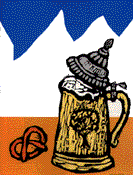
A recipe and a how-to brewing guide to Marzen, the beer that's so special Germans brew it in March and don't serve it until fall.

How many of us brew in March so that we may drink beer in September? Not very many, I would imagine - it's a long haul through the late spring and summer, a long time until tasting the results of our hard work. Yet if we were anticipating something as exquisite as a fine Märzenbier, I believe the waiting would be easier.
Prior to the advent of mechanical refrigeration, brewers were always subject to the hard rules of climate and season. Few yeasts perform well when the temperatures climb into the 70s and 80s, and many brewers suspended operation throughout the warmest months. This is still true in Belgium's lambic breweries, which have avoided the technological mark of time. A lot of homebrewers can relate, I'm sure without a cool basement or a spare refrigerator, many homebreweries shut down in the summer, their owners surviving on commercial beers or the dwindling supply brewed in the spring.
In the middle of the 19th century, Anton Dreher and Gabriel Sedlmayr revolutionized brewing science. Hell, they revolutionized beer when they "discovered" bottom-fermenting yeasts and developed the technology to commercially brew lager beers. Brewing in separate cities (Vienna and Munich) but in collaboration, they turned Europeans into lager drinkers virtually overnight. (Brewers in Plzen introduced their very pale, enormously successful version almost immediately afterward.) While the Munich lagers tended to be dark and fairly sweet, Dreher's Viennese version was copper colored and drier. He used the same high- quality Moravian malt that was used in pilsner, but his Vienna malt was kilned at higher temperatures, resulting in greater color and more malt flavor.









